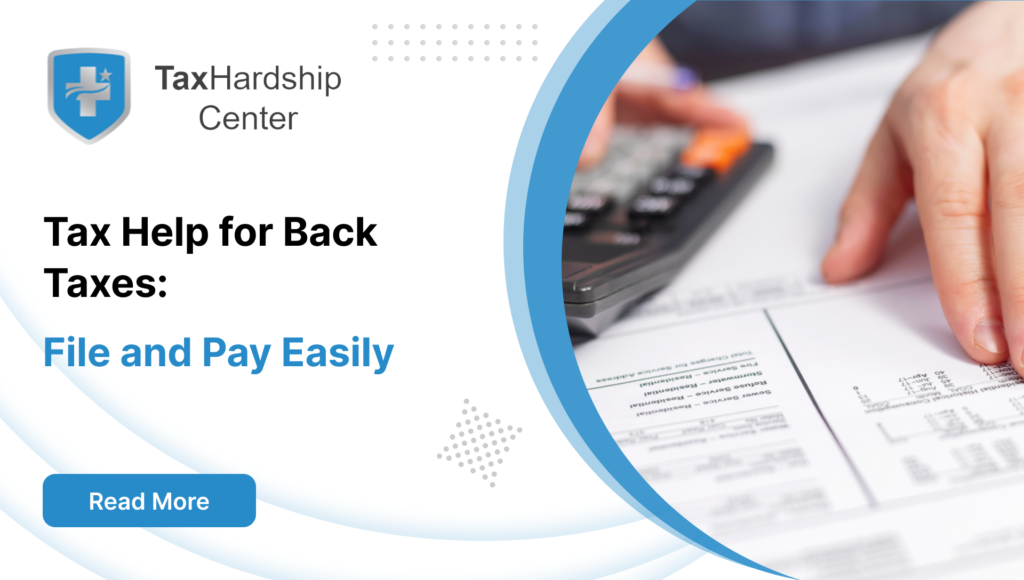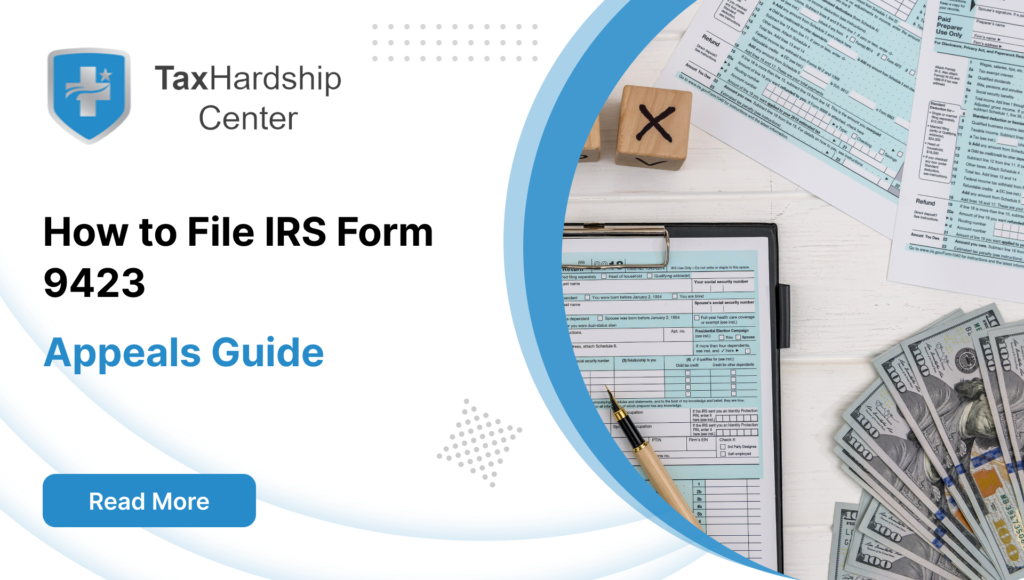If you owe taxes to the IRS, you may be wondering what options you have to reduce or eliminate your debt. The IRS offers two main programs for taxpayers struggling to pay taxes: IRS debt forgiveness and Offer in Compromise.
These programs have different eligibility criteria, benefits, and drawbacks, and choosing the right one for your situation can be challenging. It is always best to consult a tax professional company like Tax Hardship Center for a faster and more effective solution.
Tax Hardship Center has a team of experts who can help you negotiate with the IRS and find the best relief option for your case. Contact us today and get rid of your tax worries.
Navigating the IRS debt settlement choices can be very confusing. Making the best financial relief decisions requires understanding the differences between an IRS forgiveness program and an Offer in Compromise.
Critical Differences in Debt Reduction: Forgiveness vs. Offer in Compromise (OIC)
Here, we break down the core disparities that can significantly impact your financial landscape:
1. Nature of Debt Handling
Debt Forgiveness:
- What it Involves: Cancelling a portion or the entirety of tax debt.
- Triggering Factors: Often linked to specific situations like bankruptcy or insolvency.
- Tax Implications: The forgiven debt may be taxable income, subject to specific exemptions or exclusions.
Offer in Compromise (OIC):
- What it Involves: Negotiating with the IRS to pay a reduced amount compared to the total owed.
- Triggering Factors: Driven by genuine financial hardship or the inability to pay the total tax obligation.
- Tax Implications: The agreed-upon lower amount is not taxable income, offering immediate relief.
2. Immediate Debt Relief vs. Negotiation
Debt Forgiveness:
- Immediate Relief: Entire or partial debt is absolved, providing instant respite from repayment obligations.
Offer in Compromise (OIC):
- Negotiation Required: Presenting a case to the IRS, negotiating a reduced payment amount, not immediate debt cancellation.
3. Level of Documentation and Rigor
Debt Forgiveness:
- Documentation: This relies on situations like bankruptcy or insolvency, often requiring less documentation.
Offer in Compromise (OIC):
- Documentation: In this rigorous process, applicants must prove genuine financial hardship and provide detailed financial documentation.
4. Tax Liabilities and Implications
Debt Forgiveness:
- Taxable Income: Forgiven debt may constitute taxable income, impacting the taxpayer’s tax rate and yearly obligations.
Offer in Compromise (OIC):
- Immediate Tax Obligations: While the reduced amount isn’t taxable income, immediate tax responsibilities for the current year must be fulfilled.
5. Consideration of Financial Hardship
Debt Forgiveness:
- Insolvency Focus: Suitable for individuals facing insolvency where liabilities exceed assets.
Offer in Compromise (OIC):
- Financial Hardship Focus: Requires proving genuine financial difficulty and the inability to pay the entire tax obligation.
Understanding these fundamental distinctions is crucial for anyone navigating the terrain of IRS debt resolution. Each avenue offers relief but demands careful consideration based on individual financial circumstances and long-term tax implications.
Eligibility Criteria for Debt Forgiveness
Bankruptcy Filings:
Filing for bankruptcy frequently makes one eligible for an IRS forgiveness program. This can result in the discharge of some tax debts, relieving the taxpayer of heavy obligations.
Insolvency Status:
Taxpayers facing insolvency whose liabilities exceed their total assets might be eligible for debt forgiveness. This status may lead to exemptions from paying the IRS the total amount owed.
Mortgage Forgiveness Debt Relief Act:
Under certain conditions, this Act exempts taxpayers from paying taxes on some canceled debt forgiven for a principal residence’s mortgage obligation.
Qualifying Factors for Offer in Compromise
Proven Financial Hardship:
To be eligible for an Offer in Compromise, a person must be able to prove that they are genuinely in financial hardship or that paying their whole tax obligation will seriously impair their standard of life.
Ability to Pay:
The IRS considers the taxpayer’s income, expenses, asset equity, and overall financial status to ascertain if full payment is possible. The applicant must prove they need more money to pay the taxes owed.
Doubt as to Liability:
Some applicants submit an Offer in Compromise because they contest the assessed tax or claim they don’t owe the entire amount due, raising doubts about the validity of the tax responsibility.
Efficient Tax Administration:
Suppose full payment of the tax obligation will put the taxpayer in a difficult financial situation but does not meet the regular requirements. In that case, the taxpayer may request an OIC for humanitarian or extraordinary reasons.
Compliance with Filing and Payment Requirements:
Taxpayers who apply to an Offer in Compromise must comply with filing all necessary tax returns and paying their estimated annual taxes on time.
Open Bankruptcy Proceedings:
Until the bankruptcy case is resolved or dismissed, those with active bankruptcy files are often ineligible to qualify for an Offer in Compromise.
Navigating IRS Debt Forgiveness: A Step-by-Step Guide
If you’re considering IRS debt forgiveness, understanding the process is crucial. Follow these steps to navigate the intricacies of debt forgiveness with ease.
IRS Debt Forgiveness Application Form – Form 982
When you’ve decided to explore the path of IRS debt forgiveness, the next crucial step is to fill out the appropriate forms. For debt forgiveness, particularly in cases of insolvency or bankruptcy, Form 982 (Reduction of Tax Attributes Due to Discharge of Indebtedness) is a pivotal document.
Here’s a brief breakdown of what Form 982 entails:
Part I – General Information:
Provide your details, including your name, address, and taxpayer identification number.
Part II – Discharge of Indebtedness Due to Insolvency:
This section is essential if you claim insolvency as the reason for debt forgiveness. List your assets and liabilities to demonstrate your financial condition.
Part III – Discharge of Qualified Principal Residence Indebtedness:
If your forgiven debt relates to your principal residence, follow the instructions in this section. Certain conditions, like the Mortgage Forgiveness Debt Relief Act, might apply.
Part IV – Reduction of Tax Attributes Due to Discharge of Indebtedness (Not Including Qualified Principal Residence Indebtedness):
This part deals with other tax attributes that might be affected by the discharge of indebtedness.
Part V – General Exceptions to the Reduction of Tax Attributes:
Check if any general exceptions apply to your situation, which might affect the reduction of tax attributes.
Part VI – Other Information:
Additional information and specific details related to your case.
Remember, the proper completion of Form 982 is vital for a successful IRS debt forgiveness application. Seeking guidance from tax professionals, like the Tax Hardship Center, can ensure accurate and thorough completion, increasing the chances of a favorable outcome.
Initiating Offer in Compromise: The Essential Forms
IRS Offer in Compromise Application Form – Form 656
Embarking on the path of an Offer in Compromise (OIC) to settle your tax liabilities involves a critical step: completing the necessary forms. In the case of an OIC, Form 656 (Offer in Compromise) is the cornerstone document. This form allows you to propose a compromise amount to satisfy your tax debt, providing a potential lifeline for those facing financial hardships.
Let’s delve into the critical sections of Form 656:
Section 1 – Type of Tax and Periods:
Specify the type of tax (e.g., income, employment, etc.) and the tax periods for which you are submitting the offer.
Section 2 – Contact Information:
Provide your details, including your name, address, Social Security Number, and other relevant contact information.
Section 3 – Proposal Summary:
Outline the details of your offer, including the proposed settlement amount and payment terms.
Section 4 – Basis for Doubt as to Liability (Section 4 only applies if you’re disputing the amount you owe):
If you believe there is a doubt as to the correctness of the tax liability, present your arguments in this section.
Section 5 – Basis for Doubt as to Collectibility:
Demonstrate your financial hardship and why you cannot pay the entire tax debt. This is a critical section for proving eligibility for an OIC based on economic hardship.
Section 6 – Acceptance Period and Terms:
Confirm your understanding of the terms and conditions, including adhering to tax laws during the acceptance period.
Section 7 – Declaration of Taxpayer:
Sign and date the declaration, certifying the accuracy and completeness of the information provided.
Section 8 – Declaration of Representative (if applicable):
If you have a tax professional representing you, they can complete this section.
Submitting a comprehensive and accurate Form 656 is vital for a successful Offer in Compromise application. The Tax Hardship Center, with its expertise in tax resolution, can guide you through the intricacies of the process, increasing your chances of a favorable outcome.
Now that we’ve gained a comprehensive understanding of the IRS Debt Forgiveness Program and the Offer in Compromise (OIC) process let’s delve into a real-life case study that vividly illustrates the choices individuals face when dealing with substantial tax liabilities.
Case Study: John’s Dilemma – Navigating IRS Debt Relief Options
Background:
A middle-income taxpayer, John found himself grappling with a substantial IRS debt. Uncertain about the best way forward, he explored the differences between IRS debt forgiveness and an Offer in Compromise (OIC) to determine the most suitable option for his financial situation.
Debt Forgiveness Evaluation:
John began by assessing his eligibility for debt forgiveness:
- Financial Hardship: John demonstrated significant financial hardship when facing a challenging financial situation due to unexpected medical expenses.
- Insolvency Examination: John’s liabilities exceeded his total assets, meeting one of the criteria for debt forgiveness.
Consultation with Tax Experts:
Understanding the potential tax ramifications, John consulted tax experts to weigh the pros and cons of debt forgiveness. They explained the implications of taxable income resulting from forgiven debt under specific circumstances.
Bankruptcy Consideration:
Given his financial distress, John considered filing for bankruptcy, understanding its potential impact on discharging certain tax debts.
Mortgage Forgiveness Debt Relief Act Exploration:
John investigated the Mortgage Forgiveness Debt Relief Act and found potential exemptions that might apply to his situation.
Documentation and Application:
John meticulously compiled the necessary financial documents and submitted his application for IRS debt forgiveness.
IRS Response and Decision:
After patiently waiting, John received a response from the IRS. The decision outlined the extent of debt forgiven, considering his financial hardship.
Tax Implications:
Understanding the tax implications, John realized that while debt forgiveness alleviated his immediate financial burden, he needed to be aware of potential taxable income and adjust his tax planning accordingly.
Offer in Compromise Comparison:
In parallel, John explored the option of an Offer in Compromise:
- Proven Financial Hardship: Demonstrated his inability to pay the entire tax obligation due to genuine financial difficulties.
- Compliance with Filing and Payment Requirements: Ensured all tax filings and payments were up to date for the current year.
Decision-Making:
Considering the complexities and potential tax consequences, John opted for an Offer in Compromise. This allowed him to negotiate a reduced settlement amount without immediate tax implications.
Outcome:
John successfully navigated his IRS debt challenges by choosing an Offer in Compromise, avoiding immediate tax obligations, and securing a more manageable financial arrangement.
John’s case illustrates individuals’ nuanced decision-making when considering IRS debt relief options. Whether opting for debt forgiveness or an Offer in Compromise, understanding the differences and seeking expert advice ensures a more informed and tailored approach to financial recovery.
If you find yourself in a similar situation, the Tax Hardship Center is here to assist you in making the right choices aligned with your unique circumstances.
Assessing Debt Forgiveness Feasibility
Whether or not to forgive debt requires a severe assessment of particular conditions and the criteria for qualifying as deserving. Initially, suitability tests based on insolvency or bankruptcy should be assessed. Debt forgiveness may be a solution for individuals with more liabilities than assets in insolvency situations.
Finally, it is essential to know the tax implications because the amount is often treated as taxable income, except the exclusions exist. Assessment of probable tax implications allows for evaluating the total financial effect the relief would cause.
Determining Suitability for Offer in Compromise
The IRS considers factors for an Offer in Compromise eligibility, including ability to pay, equity, and hardship. The person has to prove he cannot afford to pay the entire tax due to genuine financial difficulties or lack of money. It is essential to assess all financial documentation as it constitutes a basis for proving the individual’s inability to meet the total tax obligation.
This evaluation shows that all the debt would constitute an undue hardship on the taxpayer. Secondly, assessing compliance with tax filing and payment obligations is essential. The tax filings and payments should be up to date for this current year, or the application may fail.
These are two of the most common programs the IRS offers to taxpayers facing financial difficulties and needing relief from their tax debt. However, choosing the right program for your situation is complex, and applying for it can be complicated and time-consuming. That’s why we recommend contacting Tax Hardship Center, a professional tax company that can help you find the best solution for your case.
Tax Hardship Center has a team of experienced and qualified experts who can negotiate with the IRS on your behalf and get you the best possible outcome. Don’t let your tax debt ruin your life. Contact the Tax Hardship Center today and get a free tax consultation.








